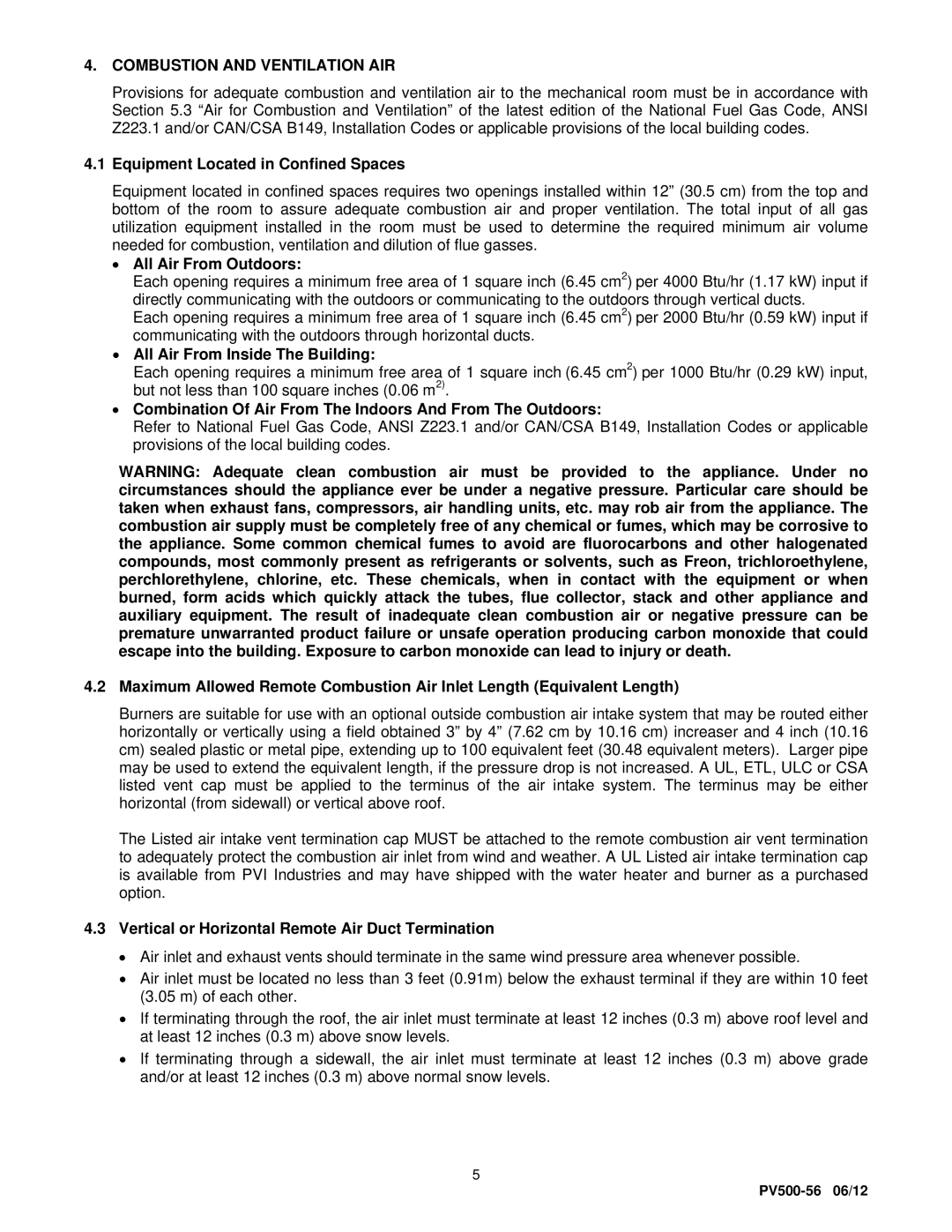4.COMBUSTION AND VENTILATION AIR
Provisions for adequate combustion and ventilation air to the mechanical room must be in accordance with Section 5.3 “Air for Combustion and Ventilation” of the latest edition of the National Fuel Gas Code, ANSI Z223.1 and/or CAN/CSA B149, Installation Codes or applicable provisions of the local building codes.
4.1Equipment Located in Confined Spaces
Equipment located in confined spaces requires two openings installed within 12” (30.5 cm) from the top and bottom of the room to assure adequate combustion air and proper ventilation. The total input of all gas utilization equipment installed in the room must be used to determine the required minimum air volume needed for combustion, ventilation and dilution of flue gasses.
All Air From Outdoors:
Each opening requires a minimum free area of 1 square inch (6.45 cm2) per 4000 Btu/hr (1.17 kW) input if directly communicating with the outdoors or communicating to the outdoors through vertical ducts.
Each opening requires a minimum free area of 1 square inch (6.45 cm2) per 2000 Btu/hr (0.59 kW) input if communicating with the outdoors through horizontal ducts.
All Air From Inside The Building:
Each opening requires a minimum free area of 1 square inch (6.45 cm2) per 1000 Btu/hr (0.29 kW) input, but not less than 100 square inches (0.06 m2).
Combination Of Air From The Indoors And From The Outdoors:
Refer to National Fuel Gas Code, ANSI Z223.1 and/or CAN/CSA B149, Installation Codes or applicable provisions of the local building codes.
WARNING: Adequate clean combustion air must be provided to the appliance. Under no circumstances should the appliance ever be under a negative pressure. Particular care should be taken when exhaust fans, compressors, air handling units, etc. may rob air from the appliance. The combustion air supply must be completely free of any chemical or fumes, which may be corrosive to the appliance. Some common chemical fumes to avoid are fluorocarbons and other halogenated compounds, most commonly present as refrigerants or solvents, such as Freon, trichloroethylene, perchlorethylene, chlorine, etc. These chemicals, when in contact with the equipment or when burned, form acids which quickly attack the tubes, flue collector, stack and other appliance and auxiliary equipment. The result of inadequate clean combustion air or negative pressure can be premature unwarranted product failure or unsafe operation producing carbon monoxide that could escape into the building. Exposure to carbon monoxide can lead to injury or death.
4.2Maximum Allowed Remote Combustion Air Inlet Length (Equivalent Length)
Burners are suitable for use with an optional outside combustion air intake system that may be routed either horizontally or vertically using a field obtained 3” by 4” (7.62 cm by 10.16 cm) increaser and 4 inch (10.16 cm) sealed plastic or metal pipe, extending up to 100 equivalent feet (30.48 equivalent meters). Larger pipe may be used to extend the equivalent length, if the pressure drop is not increased. A UL, ETL, ULC or CSA listed vent cap must be applied to the terminus of the air intake system. The terminus may be either horizontal (from sidewall) or vertical above roof.
The Listed air intake vent termination cap MUST be attached to the remote combustion air vent termination to adequately protect the combustion air inlet from wind and weather. A UL Listed air intake termination cap is available from PVI Industries and may have shipped with the water heater and burner as a purchased option.
4.3Vertical or Horizontal Remote Air Duct Termination
Air inlet and exhaust vents should terminate in the same wind pressure area whenever possible.
Air inlet must be located no less than 3 feet (0.91m) below the exhaust terminal if they are within 10 feet (3.05 m) of each other.
If terminating through the roof, the air inlet must terminate at least 12 inches (0.3 m) above roof level and at least 12 inches (0.3 m) above snow levels.
If terminating through a sidewall, the air inlet must terminate at least 12 inches (0.3 m) above grade and/or at least 12 inches (0.3 m) above normal snow levels.
5
